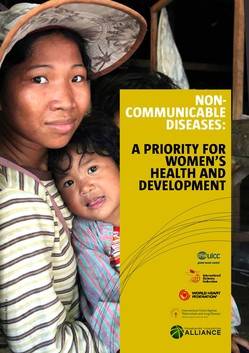 The NGO Committee on the Status of Women/New York and the NGO Committee on Mental Health recently held a panel session in the UN community on the relation between gender equality and non-communicable diseases (NCDs). NCDs are currently divided into four categories: cancers, cardiovascular disease, chronic respiratory diseases, and diabetes. (Interestingly, a recent Harvard study has listed Mental Health as a fifth category of NCD. However, this is not yet recognized in other official venues.) One of the central discussions at the panel was the economic impact of NCDs. Simply put, they are costly to treat. For instance, the World Economic Forum has projected that the United States will experience a 7 trillion dollar loss between the years of 2010-2025 as a result of NCDs. The high cost for medical care carries a high cost for those who suffer: 100 million people worldwide have been pushed into economic poverty because of medical expenses related to these diseases.
The NGO Committee on the Status of Women/New York and the NGO Committee on Mental Health recently held a panel session in the UN community on the relation between gender equality and non-communicable diseases (NCDs). NCDs are currently divided into four categories: cancers, cardiovascular disease, chronic respiratory diseases, and diabetes. (Interestingly, a recent Harvard study has listed Mental Health as a fifth category of NCD. However, this is not yet recognized in other official venues.) One of the central discussions at the panel was the economic impact of NCDs. Simply put, they are costly to treat. For instance, the World Economic Forum has projected that the United States will experience a 7 trillion dollar loss between the years of 2010-2025 as a result of NCDs. The high cost for medical care carries a high cost for those who suffer: 100 million people worldwide have been pushed into economic poverty because of medical expenses related to these diseases.
NCDs also disproportionately affect women. They cause 65 percent of all female deaths for women worldwide. We should not overlook the intergenerational impact either. In affecting the health of women, these diseases also impact the future health and life chances of children.
One of the challenges of treating women with NCDs is that women suffer from various forms of discrimination, including access to employment, insurance, and education. Furthermore, women with NCDs are considered—in some instances—to be less desirable for marriage. In certain contexts, this can obstruct their main route to a stable economic and social status, leaving them even more vulnerable to discrimination and disease. Thus we must focus on more than simple prevention of NCDs. Their perpetuation is connected to political, social, and economic structures which make it difficult for women to obtain equal rights, adequate prevention measures and, if needed, sufficient medical treatment. The problem is multi-faceted, and so the solution must be as well. For more information, please see the booklet, published by the NCD Alliance, entitled Non-Communicable Diseases: A Priority for Women’s Health and Development.
The panel then made way for small group discussion. We broke out into three groups, each with an individual focus. The first focused on government, the second on reaching men, and the third on reaching youth. The groups each sought to create a plan of action to bring together those members of society and the knowledge of NCDs and their impact on women and subsequently the finances of the family and the economy of the state.
As it so happened, all three of the groups ended up determining that the best course of action was to target college-aged students and, unsurprisingly, to use social media. The government group encouraged twitter use directed at specific politicians, the youth group mentioned the possibility of creating catchy, one minute videos to spread awareness and the male group brought up the #heforshe campaign and the need for the image of masculinity to include respect of and advocacy for women’s rights. In the end, all three groups agreed that conversation is paramount and that the voice of the youth is necessary to get it started.